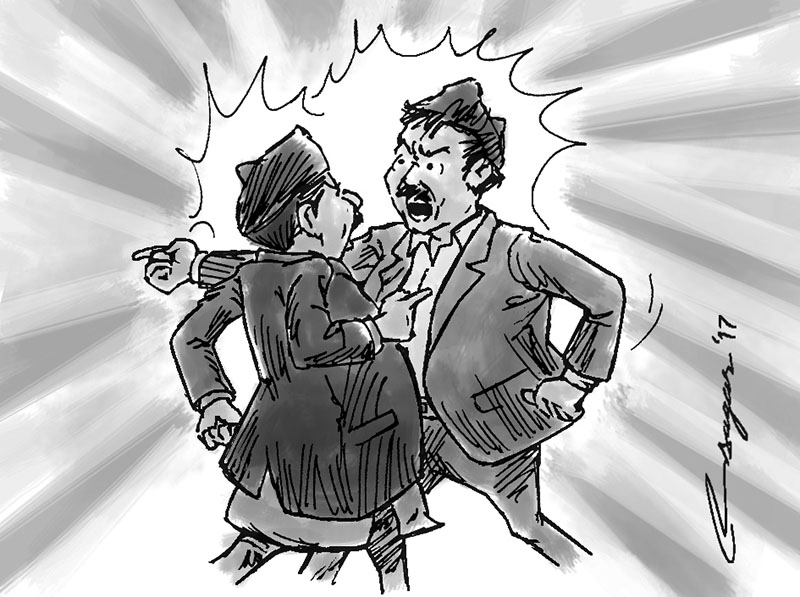Inter-party conflict: Barrier to development
National interests should be the base of the political parties’ philosophies that incorporate social, cultural, economic and sustainable aspects of development rather than any individual leader’s philosophy
Multiparty constitutional democracy in Nepal came back with the end of Panchayat system and absolute monarchy by the 1990 people’s movement.
This institutionalized the seeds of democracy, which were initiated by the 1951 movement for democracy and paved the way towards democratic governments and freedom of speech.
However, political chaos and instability became prominent as inter-party conflict became rife in Nepalese politics.
Nepal had been continued to grapple with problems of national unity, durable government, country’s sustainable socio-economic growth and international relations since the inception of multiparty democracy.
The new federal structure of Nepal with the promulgation of the new constitution in 2015 and its multilingual, cultural, religious and ethnic groups have further brought about the consequences of inter-party conflict.
Interparty conflicts are commonly inevitable in democratic setups with different party formations, which follow different political philosophy and institutional beliefs. In a country like Nepal where political transition occurs with short-lived coalition governments it can lead the country towards being a failed state.
There are more than 80 political parties and many are evolving, among them 30 parties are in the legislature-parliament of Nepal. Why is there a mushrooming of political parties? With most political parties forced to emerge due to complex prevailing socio-economic circumstances in the country, having no clear ideology and party principles, other than just to win political power and control government resources (Aristotle), the situation over time poses danger to political party stability and political order in Nepal.
Since the 1990’s people movement, Nepal had 22 coalition governments that involved more than 18 parties, mainly Nepali Congress, Communist Party of Nepal (Unified Marxist Leninist), Rastriya Prajatantra Party, Nepal Sadhbhawana Party and Communist Party of Nepal (Maoist Center), whose age ranges from a minimum of six months to a maximum of 30 months.
These governments of short duration have resulted in formidable disadvantages such as political gambling, corruption, lawlessness, organized crime, slow economic growth and failed foreign affairs. If we analyze the political events of Nepal from 1990 to 2017, we can clearly see these discrepancies in Nepalese politics.
Furthermore, Trading Economics ranked Nepal as the 131st least corrupt country in 2016 out of 175 countries, which is the third most corrupt country in South Asia. Nepal was ranked 90th in 2004, which was an all-time record low in corruption.
This shows the rampant corruption and lack of accountability that has corroded the trust of the public from political parties. While promulgating Nepal’s new constitution, at least 45 people were killed when some Madhes-based parties of Nepal started an agitation and demanded a new constitution.
This has led to extrajudicial killings and severe political chaos. Inter-party conflict in Nepal is the most intense now. Global Peace Index ranked Nepal 93rd out of 163 countries in 2017, which was 62nd in 2015.
In addition, according to the World Bank ease of doing business index, Nepal fell from 55th in 2006 to 107th in 2017; this is the reason for scanty Foreign Direct Investment.
Moreover, World Justice Project ranked Nepal 63rd out of 113 countries in 2016, which was 57th in 2014. This further clarifies the absence of rule of law and progressive reform in governments and their subsidiaries.
If we analyze all the indexes, we will find Nepal in a declining phase. Why is corruption and lawlessness becoming more rampant? Why is insecurity and violence prevailing? Why are foreign investors avoiding Nepal? The best answer to these above questions is the “inter-party conflicts” where political leaders and parties are not serious about peace, development and growth.
Greed for power, intraparty conflict, conflict of interest, political philosophies, geopolitical location, bribery, mushrooming of political parties and corruption are the main causes for inter-party conflicts in Nepal.
These shabby causes are affecting Nepal’s socio-economic development and pushing Nepal’s future into uncertainty.
Politics can change and challenge people lives. No nation can make itself a developed country if political chaos and conflict prevails. Nepal, a new federal democratic republic, which has promulgated a new constitution with ethnic/cultural diversity and political parties, national unity through political parties, is in dire need for sustainable democratic consolidation and socio-economic development.
National interests should be the base of the political parties’ philosophies that incorporate social, cultural, economic and sustainable aspects of development rather than any individual leader’s philosophy. Parties working to get common goals will have fewer conflicts to resolve.
Finally, there is need of joint efforts from all the citizens, political, religious and traditional leaders to preach and imbibe the spirit of one nation and peace, which will eventually enhance and institutionalize the multiparty democracy and constitution in Nepal.
If that is achieved, It will in turn encourage issue based ideological politics, effective and durable government, respect for principles of rule of law and accountability, separation of power, and checks and balances which are the core ingredients of democratic consolidation and Nepal’s development.






